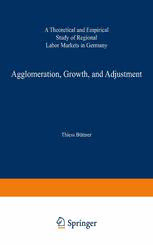
Agglomeration, Growth, and Adjustment: A Theoretical and Empirical Study of Regional Labor Markets in Germany PDF
Preview Agglomeration, Growth, and Adjustment: A Theoretical and Empirical Study of Regional Labor Markets in Germany
ZEW Economic Studies Publication Series of the Centre for European Economic Research (ZEW), Mannheim, Germany ZEW Economic Studies o.Hohmeyer,K.Rennings(Eds.) Man-MadeClimateChange EconomicAspectsandPolicyOptions 1999.VIII.401pp.ISBN3-7908-1146-7 Thiess Buttner Agglomeration, Growth, and Adjustment A Theoretical and Empirical Study of Regional Labor Markets in Germany With 10Figures and 42 Tables [W ZEW Springer-Verlag ZentrumlOrEuropAische WiftschaftsforschungGmbH Berlin Heidelberg GmbH CentreforEuropean Economic Research Series Editor Prof.Dr.Wolfgang Franz Author Thiess Büttner CentreforEuropean Economic Research(ZEW), L7, I,D-68161Mannheim,Germany ISBN 978-3-7908-1160-5 ISBN 978-3-642-51188-2 (eBook) DOI 10.1007/978-3-642-51188-2 Cataloging-in-PublicationDataappliedfor DieDeutscheBibliothek-CIP-Einheilsaufnahme Büttner,Thiess: Agglomeration.growth,andadjustment:atheoreticalandempirieal studyofregionallabormarketsinGermany;42tablesIThiess Büttner.ZEW.ZentrumfürEuropäischeWirtschaftsforschung GmbH.-Heidelberg;NewYork:Physica-Verl.,1999 (ZEWeconomicstudies) Thisworkissubjecttocopyright.Allrightsarereserved,whetherthewholeorpart of thematerialisconcemed,specificallytherightsoftranslation,reprinting,reuseofillus trations,recitation,broadcasting,reproductiononmicrofilmorinanyotherway,and storageindata banks.Duplicationofthis publicationorpartsthereofispermittedonly undertheprovisionsoftheGermanCopyrightLawofSeptember9.1965.initsCUITent version,and permissionfor usemust alwaysbeobtainedfromSpringer-Verlag Berlin HeidelbergGmbH.Violationsare liable for prosecutionunderthe German Copyright ©Springer-VerlagBerlinHeidelberg1999 OriginallypublishedbyPhysica-VerlagI1eidelbergin1999. Theuseofgeneraldescriptivenames,registerednames,rrademarks.etc.inthispublicationdoes notimply,evenintheabsenceofaspecificstarement,thatsuchnamesareexempt from the relevantprotecrivelawsandregulationsandthereforefreeforgeneraluse. Coverdesign:EricbDichiser,ZEW,Mannheim SPIN10694916 88/2202-54 32 I0- Printedonacid-freepaper Ta Clandia Preface Lately,in the context ofagrowing significanceof international economic re lations locational issues have recovered attention in economics and policy. As much ofthe recent attention is due to the labor market consequences of location decisions,the current study isconcerned with the link between the spatialeconomy and the labor market. With the aim at providing insights into thedeterminantsofregionallabor marketdisparitythestudyfocuseson some centralissues,such as location,mobility,and regional wageformation. From an empirical point of view those issues are quite underexplored, and often the literature is confined to case studies. Therefore, the study seeks to giveempiricalcontent to centralhypotheses using regionalpaneldata for Germany. Leaving many specific questions for further research the study hopefully demonstrates the usefulness of a regionally disaggregated investi gationofthelabor market. The study was accepted as a dissertation at the Faculty of Economics and Statisticsofthe University ofKonstanz,Germany,at the 24th ofNovember 1997. I would like to express my thanks to my thesis supervisor Professor Dr. Wolfgang Franz for his support and encouragement. At any time in my studies at Konstanz he was a thoughtful and patient advisor providing me with both an inspiring and convivial research environment. I am also indebtedto ProfessorDr. Hans-JurgenVosgerau,whoundertookthedutyof the second supervisorandgave severalhelpful hints. Special thanksfor manyhelpfulsuggestionsand remarksgoto mycolleagues at the University of Konstanz, in particular to Bernd Fitzenberger. Many people helped me to collect and prepare the data: Uwe Blien, Wolfgang Franz,MartinKoller,UdoLehmann, Holger Liischow,Hans-JoachimSchalk, Helmut Seitz, and Alexandros Thassinopoulos. I also want to mention the help ofnumerous peopleat the BA and at severalstatisticaloffices. I thank Fiona Higinson for helping me with the English, the remaining errors and weaknesses,however,are myown responsibility. Personally,I want to thank thecrewofSYParsifalfor postponingthelast turn,whichwenowcannever undertake. Last but not least I thank my wifeClaudia for her patience,her interest,and her support. July1998 T.Buttner Contents 1 Introduction 1 1.1 Regional Disparities in Employment Growth and Unemployment . . . 4 1.2 Overview of the Study 10 2 Employment in an Interregional Equilibrium 15 2.1 LocalFactorsand IncreasingReturns. 17 2.2 Economiesof Agglomeration. . . 21 2.2.1 Stability and Adjustment 22 2.2.2 Limits to Concentration . 24 2.3 Localization Economiesfrom the Variety ofGoods 26 2.3.1 A Model with HomogeneousFinal Goods 27 2.3.2 AModel with HeterogeneousFinal Goods 30 2.4 KnowledgeSpilloversand Dynamic Externalities 37 2.5 Empirical Implicationsfor the Employment Pattern 41 3 Employment Location in German Manufacturing 49 3.1 The RegionalDistribution ofEmployment 51 3.2 The RegionalDevelopment of Employment 59 3.2.1 Descriptionof Data .. 60 3.2.2 Description ofVariables 63 3.2.3 Sectoral Employment Growth 65 3.2.4 Sectoral Growt.hof Establishment Numbers 69 X Contents 3.2.5 Total Manufacturing Employment Growth . 72 3.3 Implicationsfor the Labor Market . 75 4 Interregional Migration in Germany 81 ,1.1 General AspectsofMigrationand Employment 82 ,1.2 Local DeterminantsofRegional Migration 88 ,1.2.1 From Grossto Net Migration 90 ,1.2.2 Data and Variables . . . . . . 92 ,1.2.3 Estimation ofa Net Migration Equation 94 5 Regional Wage Formation 101 5.1 SourcesofRegional WageFlexibility . . . . . . 102 5.2 Regional Wagesand Central Wage Bargaining. 107 5.2.1 The WageCurve . . 107 5.2.2 The Restricted Firm 109 5.2.3 WageSettingofa Monopoly Union. 111 5.2.4 Implicationsfor the Regional WageLevel 116 6 Regional Wage Flexibility in Germany 121 6.1 ExistingStudies in theGerman Case . . . . . . . 121 6.2 Empirical AnalysisforWest Germany'sDistricts 126 6.2.1 Dataand Variables . . . . . . . 127 6.2.2 BasicWageCurveEstimations 128 6.2.3 SpatialIssuesin the WageCurve 133 6.2.4 DynamicAspects ofRegional Wage Flexibility 141 7 Summary and Outlook 151 A Appendix 155 Sourcesand DefinitionsofData Used in Chapter 1 155 I.l Dataon Employment Change . 155 1.2 Dataon Unemployment . . . . 156 II Sources and DefinitionsofData Used in Chapter 3 156 II.l General District LevelData . . . . . . . . . 156 Contents Xl Il.2 District Level Datafor Manufacturing Industries 157 11.3 Other Data . . . . . . . . . . . . . . . . . . 159 III Sourcesand DefinitionsofData Used in Chapter 4 160 III.I State LevelData . . 160 IlI.2 District LevelData. 161 1I1.3 Data at the Levelofthe Planning Regions. 162 IlIA Further Data . . . . . . . . . . . . . . . . . 162 IV Sourcesand DefinitionsofData Used in Chapter6 163 V Abbreviationsin theText 165 VI Thbks . .. . . .. . . . . 1~ List ofTables 189 List ofFigures 191 References 193
